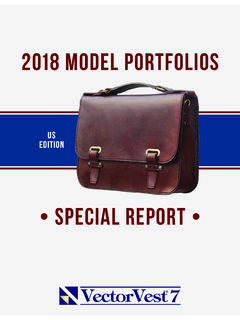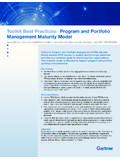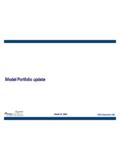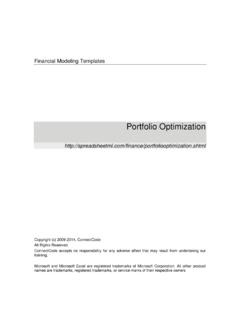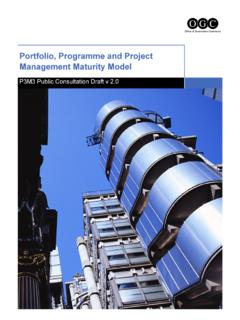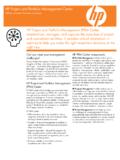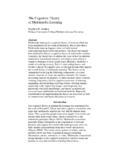Transcription of 1 Capital Asset Pricing Model (CAPM)
1 Copyrightc 2005 by Karl Sigman1 Capital Asset Pricing Model (CAPM)We now assume an idealized framework for an open market place, where all the risky assetsrefer to (say) all the tradeable stocks available to all. In addition we have a risk-free Asset (forborrowing and/or lending in unlimited quantities) with interest raterf. We assume that allinformation is available to all such as covariances, variances, mean rates of return of stocksand so on. We also assume that everyone is a risk-averse rational investor who uses the samefinancial engineering mean-variance portfolio theory from Markowitz. A little thought leads usto conclude that since everyone has the same assets to choose from, the same information aboutthem, and the same decision methods,everyone has a portfolio on the same efficient frontier,and hence has a portfolio that is a mixture of the risk-free Asset and a unique efficient fundF(of risky assets).
2 In other words, everyone sets up the same optimization problem, does thesame calculation, gets the same answer and chooses a portfolio efficient fund used by all is called themarket portfolioand is denoted byM. The factthat it is the same for all leads us to conclude that it should be computable without using allthe optimization methods from Markowitz: The market has already reached anequilibriumsothat the weight for any Asset in the market portfolio is given by its Capital value (total worthof its shares) divided by the total Capital value of the whole market (all assets together). If, forexample, assetirefers to shares of stock in CompanyA, and this company has 10,000 sharesoutstanding, each worth $ , then the captital value for assetiisVi= (10,000)($20) =$200,000. Computing this value for each Asset and summing over alln(total number of assets)yields the total Capital value of the whole market,V=V1+ +Vn, and the weightwi=Vi/Vis the weight used for assetiin the market portfolio .
3 The general idea is that assets under highdemand will fetch high prices and yield high expected rates of return (and vice versa); repeatedtrading of the assets over time adjusts the various prices yielding an equilibrium that reflectsthis; the optimal weightswifor the market portfolio are thus governed by supply and the end, we don t need to use the optimization methods nor any of the detailed data(covariances, variances, mean rates, nor even the risk-free raterf) to determine the marketportfolio; we only need all in passing that all the weightswiare positive (no shorting exists in the market portfo-lio). This implies that even if apriori we ruled out shorting of the assets in our framework, thesame equilibrium market portfolioMwould arise. Also note that since presumably all riskyassets available on the open market have a non-zero Capital value, all risky assets are includedin the portfolio (although some have very small weights).
4 The above equilibrium Model for portfolio analysis is called theCapital Asset Pricing Model (CAPM). Capital market line and CAPM formulaLet ( M,rM) denote the point corresponding to the market portfolioM. All portfolios chosenby a rational investor will have a point ( ,r) that lies on the so-calledcapital market liner=rf+rM rf M ,(1)1In the literature however, CAPM sometimes refers to results (formulas) that follow from using this we shall see at the end of this lecture, this Model leads to a formula for Pricing assets which is why the wordpricingis used in its efficient frontier for investments. It tells us the expected return of any efficient portfolio , interms of its standard deviation, and does so by use of the so-calledprice of riskrM rf M,(2)the slope of the line, which represents the change in expected returnrper one-unit change instandard deviation .If an individual asseti(or portfolio ) is chosen that is not efficient, then we learn nothingabout that Asset from (1).
5 It would seem useful to know, for example, howri rf, theexpectedexcess rate of returnis related toM. The following formula involves just that, where M,idenotes the covariance of the market portfolio with individual asseti:Theorem (CAPM Formula)For any assetiri rf= i(rM rf),where i= M,i 2M,is called the beta of asseti. This beta value serves as an important measure of risk for individualassets (portfolios) that is different from 2i; it measures the nondiversifiable part of generally, for any portfoliop= ( 1, .. , n)of risky assets, its beta can be computedas a weighted average of individual Asset betas:rp rf= p(rM rf),where p= M,p 2M=n i=1 i proving the above theorem, we point out a couple of its important consequences andexplain the meaning of the beta. For a given asseti, 2itells us the risk associated with itsown fluctuations about its mean rate of return, but not with respect to the market example if assetiis uncorrelated withM, then i= 0 (even presumably if 2iis huge),and this tells us that there is no risk associated with this Asset (and hence no high expectedreturn) in the sense that the variance 2ican be diversified away (recall our example in LectureNotes 4 of diversification ofnuncorrelated assets).
6 The idea would be to collect a large numberof uncorrelated (and uncorrelated withM) assets and form a portfolio with equal proportionsthus dwindling the variance to 0 so it becomes like the risk-free Asset with deterministic rate ofreturnrf. So, in effect, in the world of the market you are not rewarded (via a high expectedrate of return) for taking on risk that can be diversified away. So we can view ias a measureofnondiversifiable risk, the correlated-with-the-market part of risk that we can t reduce bydiversifying. This kind of risk is sometimes calledmarketorsystematicrisk. It is not true ingeneral that higher beta value iimplies higher variance 2i, but of course a higher beta valuedoes imply a higher expected rate of return: you are rewarded (via a high expected rate ofreturn) for taking on risk that can t be diversified away; everyone must face this kind of of assets that would be expected to have high beta values (today) would be thosewhich are deeply related to the general market such as stocks in big name companies likeGeneral Electric, Cisco Systems, Coca-Cola, IBM, Procter & Gamble and so :[CAPM formula]2We form a portfolio of assetiand the market portfolioM; ( ,1 ), with [0,1].
7 Therate of return is thusr( ) = ri+ (1 )rM. Assetiis assumed not efficient; it s point lies inthe feasible region but not on the efficient frontier. Thus as varies this portfolio s point tracesout a smooth curve in the feasible ( ,r) region ( ( ),r( )) parametrized by , wherer( ) = ri+ (1 )rM= (ri rM) +rM,(3) ( ) = 2 2i+ (1 )2 2M+ 2 (1 ) M, 2( 2i+ 2M 2 M,i) + 2 ( M,i 2M) + 2M.(4)When = 0, ( (0),r(0)) = ( M,rM) and when = 1, ( (0),r(0)) = ( i,ri). Thus the curvetouches the captital market line at the market point ( M,rM), but otherwise remains off thecaptital market line but (of course) within the feasible region where it also hits the point ( i,ri).We conclude that the curve is tangent to the Capital Asset line at point ( M,rM) and thereforewhen = 0 the curve s derivativedr( )d ( ) =0is identical to the slope of the Capital Asset line at pointM. The slope (the price of risk) of theline is given by (2).
8 We thus conclude that when = 0dr( )d ( )=rM rf M.(5)The composition rule from calculus yieldsdr( )d ( )=dr( )/d d ( )/d Differentiating (3) and (4) and evaluating at = 0 yieldsdr( )/d d ( )/d =ri rM( M,i 2M)/ (5) we deduce thatri rM( M,i 2M)/ M=rM rf forrithen yields the CAPM formula for asseti,ri rf= i(rM rf), as was to beshown. For the more general portfolio result, observe thatrp rf= rf+n i=1 iri=n i=1 i(ri rf)=n i=1 i i(rM rf)(CAPM formula for single asseti)= (rM rf)n i=1 i that when p= 1 thenrp=rM; the expected rate of return is the same as for themarket portfolio . When p>1, thenrp>rM; when p<1, thenrp< note that if an assetiis negatively correlated withM, M,i<0, then i<0 andri< rf; the expected rate of return is less than the risk-free rate. Effectively, such a negativelycorrelated Asset serves as insurance against a drop in the market returns, and might be viewedby some investors as having enough such advantages so as to make it worth the low in gold is thought to be such an example at Estimating the market portfolio and betasIn the real open market place where the number of assets is enormous, trying to actuallyconstruct the market portfolio would be an awsome and unrealistic task for any financial so-calledindex funds(ormutual funds) have been created as an attempt to approximatethe market portfolio .
9 Such an index is a smaller portfolio made up of what are viewed as themarkets most dominant assets, that captures the essence ofM. The most well-known suchindex is the Standard & Poor s 500-stock index (S&P), made up of 500 stocks. A beta for agiven Asset is then estimated by using the S&P in replace ofM, and then collecting past datafor both rates of return. For example consider an assetAfor which we wish to estimate itsbeta. These estimates are computed using sample means, variances and covariances as follows:We chooseNtime points such as the end of each of the last 10 yearsk= 1,2, .. , kdenote thekthsuch sample values for rate of return yielding estimates rA=1NN k=1rAk rS&P=1NN k=1rS&P variance 2S&Pis then estimated byY=1N 1N k=1(rS&P k rS&P)2,and the covariance S&P ,Ais estimated byX=1N 1N k=1(rS&P k rS&P)(rS&P k rA).The beta value is then estimated by taking the More on systematic riskWith the CAPM formula in mind, for a given assetilet us expressriasri=rf+ i(rM rf) + i,(6)where i=ri rf i(rM rf),(7)4a random variable, is the error term.
10 Note how we replaced deterministicrMwith randomrMin the CAPM to do this. Our objective is to determine some properties of the error is immediate from the CAPM formula thatE( i) = 0. MoreoverCov( i, rM) = 0 as isseen by direct computation and the definition of i:cov( i, rM) =cov(ri rf i(rM rf), rM)=cov(ri i(rM rf), rM)=cov(ri, rM) icov(rM rf, rM)=cov(ri, rM) icov(rM, rM)= M,i M,i 2M 2M= M,i M,i= the error term has mean 0 and is uncorrelated with the market portfolio . It then followsby taking the variance of both sides of (6) that 2i= 2i 2M+var( i).(8)We conclude that the variance of assetican be broken into two orthogonal components. Thefirst, 2i 2M, is called thesystematicrisk and represents that part of the risk (of investing in asseti) associated with the market as a whole. The other part,var( i), is called thenonsystematicrisk. The nonsystematic risk can be reduced (essentially eliminated) by diversification, but thesystematic risk, when 2i>0, can not be diversified for in terms ofrin the Capital market line yields the inverse line for efficientportfolios =r rfrM rf the CAPM formularp rf= p(rM rf) and plugging into this inverse line formula,we conclude that for any efficient portfoliop, p= p M; there is only systematic risk forefficient portfolios, no nonsystematic risk.










